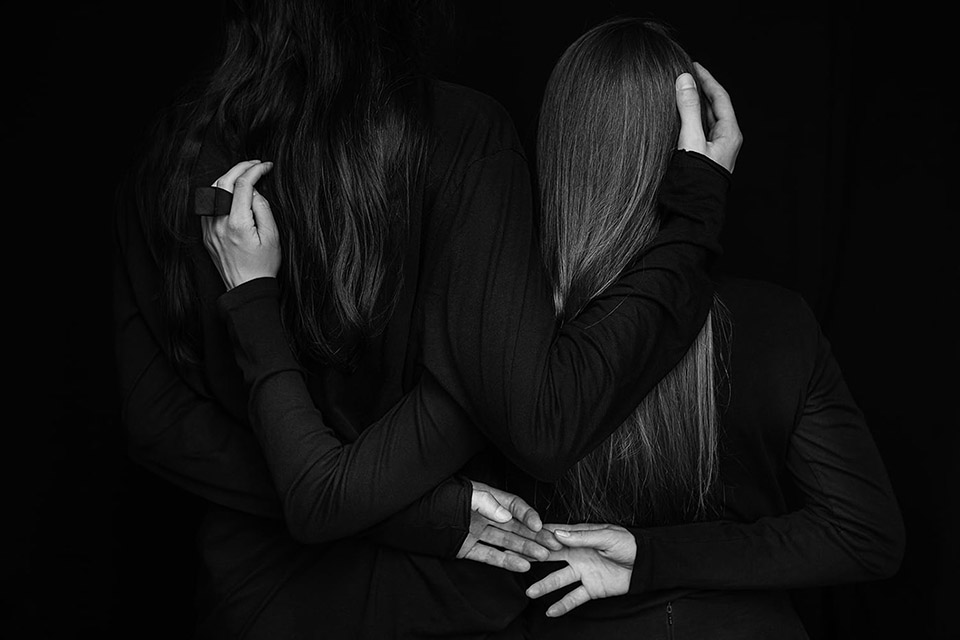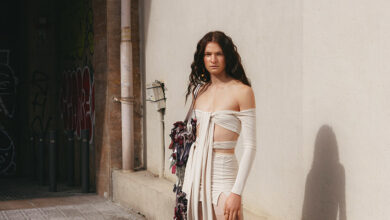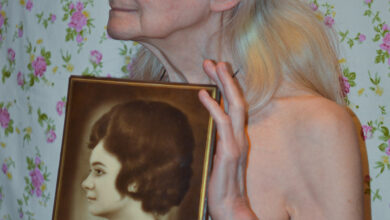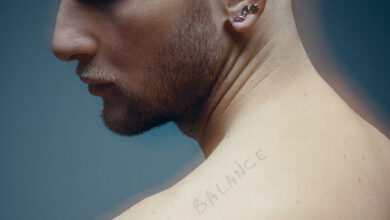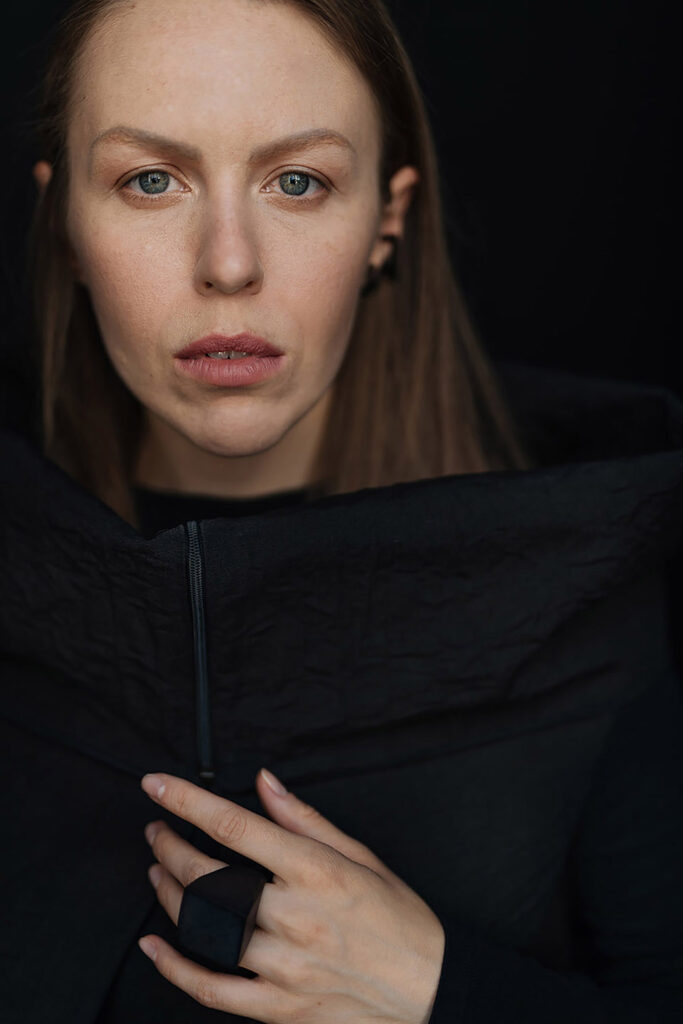
Ukrainian fashion designer and stylist Irina Dzhus has been following one principle since she founded her brand, DZHUS: learn as much as possible about the history of fashion to avoid copying and create something completely new.
Born in Kyiv in 1988, Dzhus has been designing innovative, functional pieces since she graduated from Kyiv National University of Technologies and Design. After founding her avant-garde ethical and cruelty-free conceptual label in 2010, she went from strength to strength. Short-listed for the International Woolmark Prize in 2015, DZHUS is currently sold online worldwide and in concept stores in Australia, Japan, Portugal, Saudi Arabia, the UAE and the US.
Dzhus’s designs are characterized by architectural silhouettes and geometrical pleats that create complex configurations and biomorphic shapes. Her latest collection is an ode to the transformative power of fashion, and reimagines the possibilities of reducing waste and consumption. Each design in this collection can be transformed into something else, thanks to ingenuously placed metal zippers and press studs. A quilted dense cotton hat can be turned into a bag or worn as a harness sleeve; skirts, bras and hoods double as bags; a pleated wide-leg jumpsuit transforms into two-layered trousers or can be worn as a cape or a hood; while a multipurpose bi-coloured design can be styled as a jumpsuit, a coat, a dress and a two-layer jacket, or transformed into two hats or bags or a hat and a bag. And there’s some added value as well: the packaging – a classic universal shopping bag made with fabric rather than plastic – can be easily transformed into a practical yet iconic dress or top.
These transformative designs have now taken a new meaning: Dzhus’s life was recently radically transformed by the war in Ukraine. When the Russian invasion started, Dzhus had to leave Vyshhorod, a city on the outskirts of Kyiv, where she lived with her husband, Anatolii Elgert, and their three cats, Eva, Timur and Sargon. After boarding separate trains for Western Ukraine, they were reunited in Lviv, only to be separated again while fleeing the country, as men are required to remain.
Dzhus arrived in Warsaw with her cats and part of her collection, and her plan now is to sell her pieces while re-establishing her brand. Part of the profits will be donated to the Ukrainian army and to animal shelters, and the rest will be used to help her brand survive.
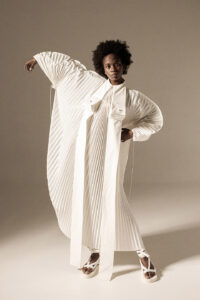
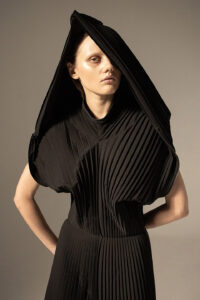
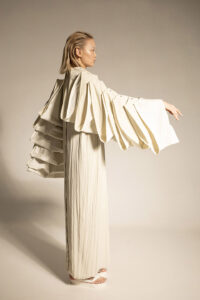
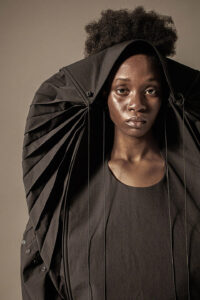
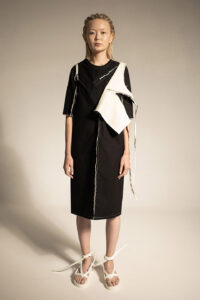
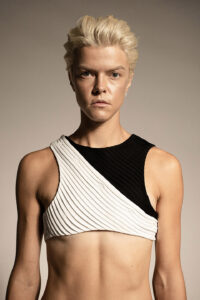
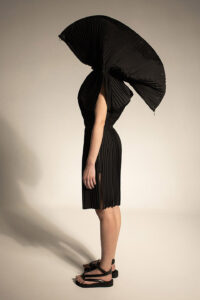
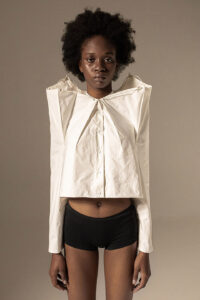
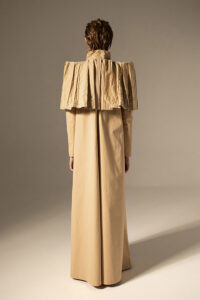
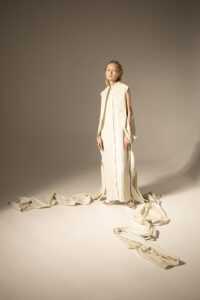
Below are excerpts from Zoot’s conversation with Irina Dzhus.

Zoot Magazine: Where were you when the war started and how has it affected your life, your family and friends?
Irina Dzhus: The morning of February 24th, 2022, began with explosions on the horizon. That was chillingly horrifying, and in five minutes, I was already packing my necessities for a possible evacuation. However, even at that shocking moment, we couldn’t imagine any of the events that were yet to follow. We still hoped that Putin would focus only on military targets as threatened. But soon we got news that they had killed officers on the border and were moving towards Kyiv. The news left me speechless and scared, I couldn’t imagine such a violence from anyone but a maniac. Meanwhile, the bombing continued and, together with my husband Anatolii, who’s also my business partner and manages production, logistics and legal issues for DZHUS, packed our three cats into carriers and went to the closest bomb shelter. We spent the next two days in a basement of our apartment block, hearing frequent explosions and shooting. For our pets, it was extremely stressful to sit in the containers for so long, surrounded by a crowd of people who were also hiding there with their children and pets. Our cats refused to eat and drink and were either panicking or apathetic. Finally, Anatolii decided he would risk his own safety and return home with them, as that was the only place where they felt fine. I spent two more days in the basement, with short visits home to take a shower. During all this time, we desperately wanted to evacuate, but it was extremely risky to try getting from our suburbs to Kyiv railway station, as the northern outskirts of Kyiv were a very dangerous area. When another curfew ended and the situation got a bit safer, I left the shelter with the intention of fleeing on the same day. A family friend kindly agreed to drive us, and in a few hours, we were at the station. My husband had problems in getting on evacuation trains because women and children were prioritised, and there was an endless crowd of candidates. To avoid making things worse for our cats, I agreed to get on one of the trains with them while Anatolii awaited till the next morning, when he finally boarded a train. The conditions for both of us were very tough, yet luckily we made it safe to Western Ukraine.
What has the war meant for you so far?
ID: For us it meant a pause in the brand’s work, as all our production team left too. It is obviously too dangerous to go to work, and there is also the fabric supply issue. No need to even mention my work as a stylist, considering the situation. I only have two closest relatives, my mom and auntie, both residing in Kharkiv, one of the most attacked cities. It took me a few days to persuade them to evacuate abroad too, because in their region even going out to buy some bread could have been fatal.
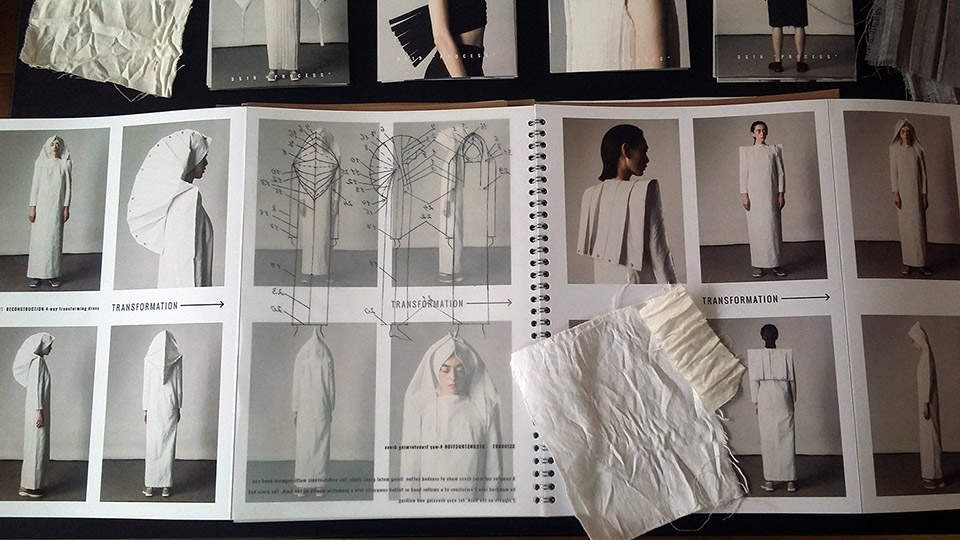
Why did you decide to move to Poland and who did you leave behind?
ID: Hiding from bombing, we’ve received an immense amount of help offers from around the world, and Polish friends suggested me to stay in their spare apartment in Warsaw. It sounded great to me, as I always try to avoid crowded places, whereas a separate flat was perfect to focus on work and retreat. Sadly, by then, our state had already announced martial law, according to which men aren’t allowed to leave the country. This meant I had to flee abroad on my own to save our pets and at least a selection from DZHUS’s S/S 22 stock, to resume the brand’s activity as soon as the circumstances would allow. I left my heart with my dear husband and most of the brand’s heritage. I can only hope that this nightmare will end soon.

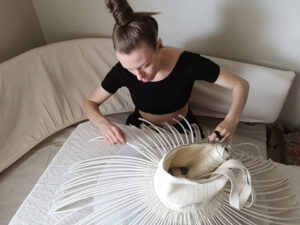
What has been the scariest moment for you so far?
ID: The first few days were the most horrific. I was so shocked that I could neither sleep nor eat. I was unable to breathe properly and felt thirsty all the time. My thinking process didn’t stop, as I was considering solutions. I have OCD and panic attacks. In normal life, panic is no big deal as long as you can manage to concentrate on the fact that the problem isn’t really serious and, objectively, you are and will be ok. Definitely not this case. For what regards OCD, I’m even grateful to it for all my creative achievements: because I’m so abnormally focused on specific details, my work is so peculiar. However, being obsessive-compulsive is not an ideal condition in a war. I felt jealous of people who could distract themselves by playing cards, watching a TV show or having small talks while hiding in the basement. To me, it didn’t make any sense when we could die at any moment. I couldn’t understand how could everyone be so unimaginably fearless and wondered if they hadn’t fully realised what the risks of sitting under bombing implied or if they didn’t value their lives that much. My brain treats all issues in order of importance, and danger for me was the first issue to take into account and sort out. Those few days of endless horror were such a traumatic experience, I would compare them with rape.
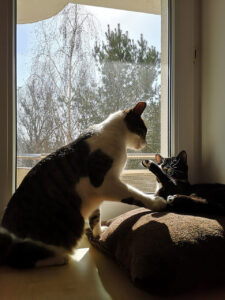
What’s your routine at the moment and what’s your life like now?
ID: Now that the cats and I found our temporary home in Warsaw, I’m adapting myself to the new reality, step by step, enjoying the city and doing some work. So far, I’ve focused on two points: PR, as I’m sure it’s highly important now to speak up about Russia’s crime against humanity, and sales, to be able to raise funds to support my country.
What do you plan to do with the collection you managed to bring with you?
ID: I had to make a super small selection that would fit in one luggage piece, as I already had three cats with me, and it was clear the trip would be very challenging. Usually, we work on a made-to-order basis, keeping only one piece in size S per item, but now I don’t have any connections with the manufacturing industry here in Poland, and I don’t have our fabrics with me, so the production isn’t functioning, and we can only sell the drop I managed to bring. Using that as a starting point, I’ve just launched a stock sales campaign, with 30-50% of the profit to be donated to the Ukrainian army and to animal shelters; the rest will be used to support the brand. I’ll send proof of the donations to every customer, so they can be sure their purchase will help my country and not just my business.
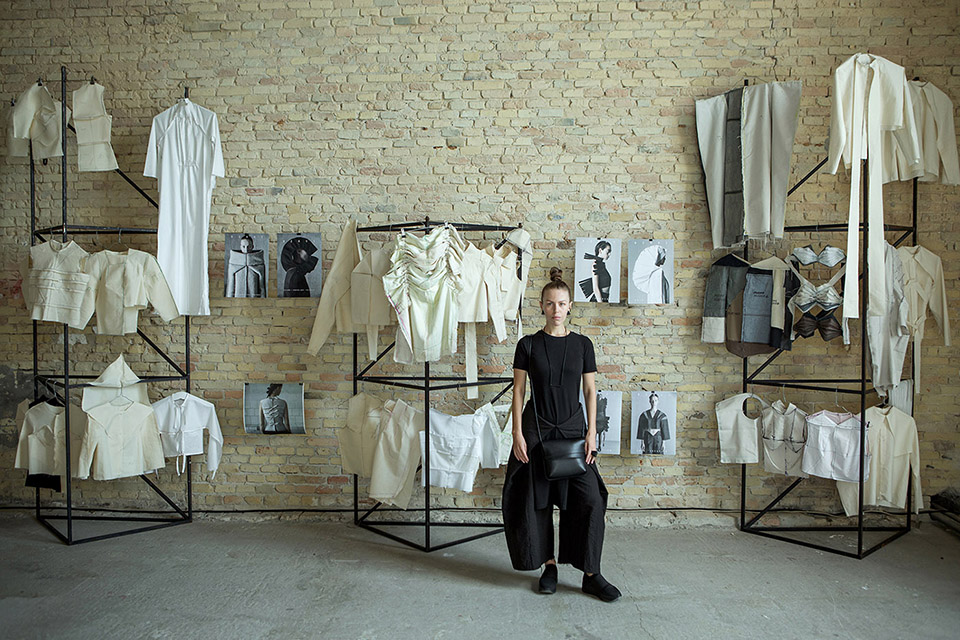
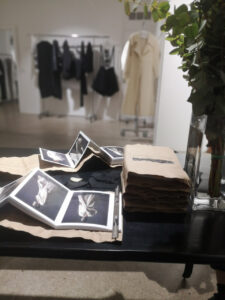
Speaking of your business, your collections look conceptual, but they are also very artisanal. How did you develop your unique style throughout the years?
ID: When I was a teenager, I got to know my favourite Ukrainian designer Victoria Krasnova and did an internship at her studio to learn from her unique approach to creation. The main thing she taught me from the very beginning was the principle of learning as much as possible about fashion to avoid copying someone else’s work. I’m still following that principle. She also taught me interesting methods to analyse the source of inspiration and interpret it in my designs. As the years passed, I pushed myself to create more sophisticated conceptual pieces. Along with that, my skills in pattern-making and technologies improved from one collection to another. As a result, I developed quite complex patterns, and I do my best to make sure they aren’t reminiscent of any other designer’s previous ideas.
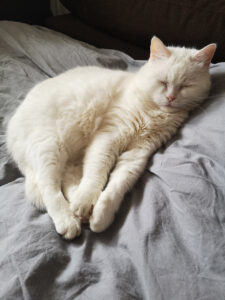
Do you know other designers or artists who are at the moment in Ukraine fighting or volunteering?
ID: All the men from our industry have no choice but to stay in Ukraine and help the community in one way or another. My husband doesn’t have a soldier’s frame of mind; we are very peaceful people, but he couldn’t just sit and wait, so he started attending useful training to help the army. I know designers who are now making camouflage nets, bulletproof vests or other military equipment. But, of course, it’s not only men who stayed in the country. Many women, including art and fashion specialists, decided not to leave their Motherland and assist with whatever is needed. And finally, many businesses are stoically continuing their work, mostly to satisfy people’s needs in these hard times rather than to gain profit.
Other countries were surprised by how passionately Ukraine President Volodymyr Zelenskiy is protecting the country, making speeches, posting videos on social media and giving interviews. Was there any moment when you were personally surprised by your own country?
ID: Many people, including me, were surprised by the President’s heroic attitude. In peaceful times, he was considered adequate and that was it. But, like it happens to superheroes, he needed special circumstances to discover his superpower. I was also amazed by our people’s braveness in front of the invaders, and their loyalty to our identity and culture. No matter how unbearable the conditions are, our communities, cities and villages just won’t give up. Ironically, what was meant to ruin Ukraine, has now taken the nation to a new level.
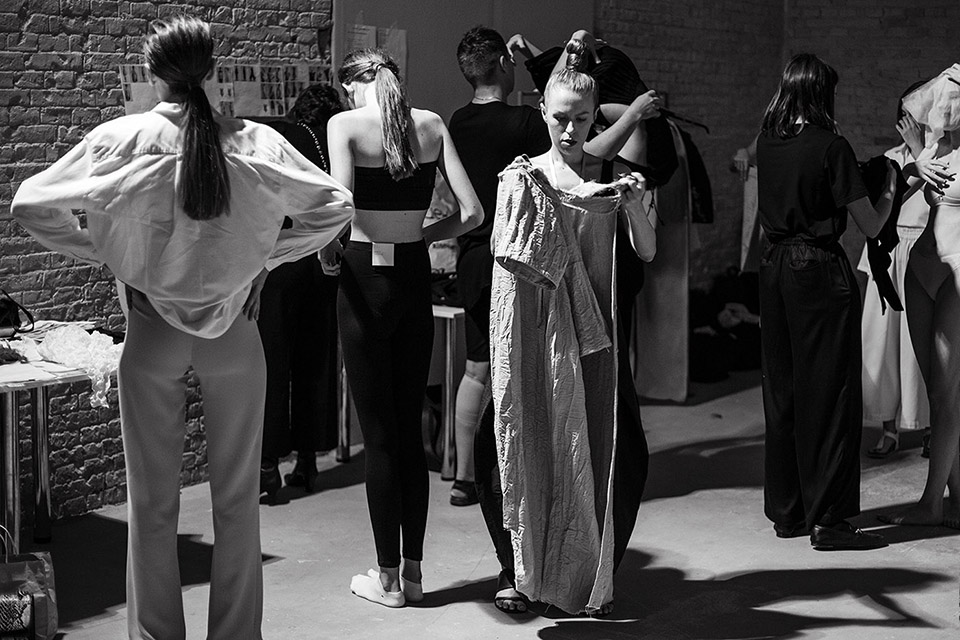
What do you think the international fashion community could do to help Ukrainian people?
ID: Hiring professionals from Ukraine would be extremely helpful – not only refugees but also those who work online from home. Providing as much information as possible also about other countries where we may be staying would be priceless as well. For instance, I’m now lacking information about the Polish industry, and even though I have friends in the local fashion community, I still have plenty of questions. It’d be perfect to make a fashion- and style-related online network (maybe even with physical hubs in big cities) with diverse data about employers, professional events, contests, support programs, creative projects and so on, targeted for Ukrainians who had to flee their country or cannot do their job in Ukraine right now.
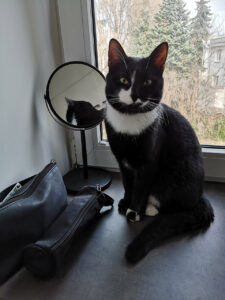
How can we all help?
ID: I think it’s important not to forget Ukraine, even if the war takes longer than we hope, and continue highlighting the catastrophe our country is facing. During the first days of the war, top press from all over the world wrote about it, which helped so much influencing politicians’ decisions about support. Now there’s already less interest to this tragedy, as there’s not such a hype anymore. But a war doesn’t have to be “interesting”. In my opinion, it’s a duty of the media not to let the international audience forget that this act of terror is happening in 2022 to an independent democratic state right in the heart of Europe.
What’s the first thing you will do once the war is over?
ID: Reunite with my beloved husband, and finally sleep well.
